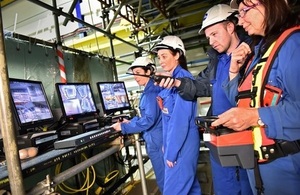Nuclear clean-up milestone makes Sellafield safer
Sellafield Ltd achieves the “most significant stride ever” in its clean-up mission. The entire bulk stocks of historic nuclear fuel are now removed from one of the site’s oldest ponds.

Workers have now removed the entire bulk stocks of historic nuclear fuel from the Pile Fuel Storage Pond
The milestone came after decommissioning teams lifted the final skip of ‘metal fuel’ from the Pile Fuel Storage Pond via a remote-controlled process. Retrieval of the pond’s ‘canned fuel’ inventory was successfully completed in October 2015.
The work means radioactivity levels at the 68-year-old spent fuel pond have now been cut by 70 per cent, vastly reducing the risk it poses to people and environment.
The achievment is the most visible sign yet of progress in the NDA’s programme to clean-up the legacy of Britain’s early nuclear industry, which is set to continue for at least another 100 years.
The removed fuel has been transferred to a modern storage building at Sellafield where it can be held in a far safer environment.
The pond played a pivotal role in the development of the UK’s original nuclear deterrent, which guaranteed Britain a seat at the global power table throughout the 20th century. This project was commissioned and delivered under the management of Nuclear Management Partners (NMP).
Spent fuel rods were cooled in the pond after they had been burned in the old Windscale Pile reactors to create weapons material.
This was at the height of the Cold War in the 1940s and 50s when a global arms race developed amid simmering tensions between the USA and the Soviet Union.
Some of the fuel used in that military campaign had sat in the murky depths of the Pile Fuel Storage Pond ever since.
The pond also played a vital support role during Britain’s worst nuclear accident – the 1957 Windscale fire. Rods pushed through the core of the reactor by brave workers battling the blaze were later transferred to the pond for storage.
More than half a century on, Sellafield is now Europe’s biggest environmental restoration project.
Pete Lutwyche, the NDA’s Sellafield Programme Director said:
This is a huge achievement in the decommissioning of Sellafield’s most hazardous facilities, and I congratulate the team on their commitment, dedication and hard work.
Paul Foster, managing director of Sellafield Ltd, said:
This is a truly landmark moment in the decommissioning of Sellafield.
Removing decades-old corroded fuel from an aging facility and placing into modern containment makes Sellafield, and the whole of the UK, a far safer place.
The enormity of the challenge cannot be underestimated – the pond was built with no design for how its contents would be removed. We have had to retro-fit an export process and then safely execute it in one of the most challenging environments imaginable.
Operators removed the fuel from 40-feet away, working behind radiation shields and using cameras and well-rehearsed procedures.
The approach required a step-change in thinking at Sellafield as it necessitated bringing fuel skips up and out of the water and therefore being ‘unshielded’ for a time.
Mr Foster added:
In order to achieve this we had to embrace new ways of working focusing on collaboration, removing barriers, fit for purpose solutions and embracing innovation.
It is essential we embed this change of approach across Sellafield Ltd to ensure we build on the achievements at the pond and drive forward with decommissioning across the site.